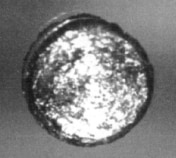Californium (Cf), atomic number 98, is a radioactive metal with a density of 15.1 g/cm³. It has a melting point of 900°C. Notable isotopes include Cf-252, with a half-life of 2.645 years, used in neutron radiography and cancer treatment. Discovered in 1950 at UC Berkeley, it’s produced in nuclear reactors and particle accelerators.
Basic Properties of Californium
Property Value Atomic Number 98 Atomic Mass 251 u Half Life 90 years Decay Modes Alpha decay, spontaneous fission Nuclear Binding Energy 1809 MeV Nuclear Cross Section Very large (>100 b) Valence Electrons 6 State at Room Temperature Solid Density 15.1 g/cm3 Number of Electrons 98 Number of Protons 98 Number of Neutrons 153 Family Actinide Period 7 Year Discovered 1950 Cost per Gram $27 million
Physical Properties of Californium
Property Value Melting Point 900°C Boiling Point 1470°C Coordination Geometry Hexagonal planar Lattice Constants a = 0.4990 nm, c = 1.070 nm Density of States Complex, see electronic properties Solubility in Water Insoluble Electrical Conductivity Moderate conductor Magnetism Paramagnetic Color Silvery white Odor Odorless Hardness N/A Vapor Pressure 1 mm Hg at 1065°C Viscosity N/A Surface Tension N/A Refractive Index N/A Specific Heat Capacity N/A Thermal Expansion N/A
Image credit: wikipedia
Chemical Properties of Californium
Property Value Reactivity Highly reactive Flammability Flammable solid Reaction with Acids Violent reaction due to rapid oxidation Reaction with Bases expected to be unstable Reaction with Oxidizing Agents Exothermic, can cause fires pH N/A Oxidation States +2, +3 Electronegativity 1.3 Corrosion Resistance Low Chemical Stability Unstable Heat of Combustion N/A Rate of Reaction Rapid oxidation in air Acid-Base Behavior N/A Redox Potential N/A
Spectroscopic Properties of Californium
Property Details Absorption Spectrum Strong absorbances in UV and visible regions Emission Spectrum Emits alpha, beta and gamma radiation Photoelectron Spectroscopy Binding energies useful for chemical analysis L III-edge XANES/EXAFS Can determine oxidation state and coordination chemistry NMR Properties N/A
Crystallographic Properties of Californium
Property Value Crystal Structure Double hexagonal close-packed Space Group P63/mmc (#194) Unit Cell Dimensions a = b = 0.499 nm, c = 1.070 nm Atomic Positions 2c (0, 0, 0) <br> 4f (1/3, 2/3, 0.097)
Electronic Properties of Californium
Property Value Band Gap N/A Electrical Resistivity N/A Fermi Level 5f5/2 orbitals Electronic Configuration [Rn] 5f10 7s2
Isotopic Composition of Californium
Isotope Half-Life Primary Decay Mode Cf-248 333.5 days Alpha decay Cf-249 351 years Alpha decay Cf-250 13.08 years Beta decay to Bk-250 Cf-251 898 years Alpha decay Cf-252 2.645 years Alpha decay, spontaneous fission Cf-253 17.81 days Beta decay to Bk-253 Cf-254 60.5 days Alpha decay, spontaneous fission
Californium Discovery
Aspect Details Discovery Year 1950 Discoverers Albert Ghiorso, Glenn T. Seaborg, Kenneth Street, Jr., and Stanley G. Thompson Location University of California, Berkeley Method Bombardment of Curium (Cm) with alpha particles
Interesting Facts on Californium
Fact Details Naming Named after the State of California and the University of California, where it was discovered. Rarity One of the most expensive elements to produce due to its synthetic production in particle accelerators. Neutron Emitter Cf-252 is a strong neutron emitter, which is rare and highly valuable for certain applications. Use in Space Considered for use in space missions as a compact neutron source for probing materials and soil.
Applications of Californium
Application Area Details Industrial Uses Neutron radiography for detecting defects in aircraft, spacecraft, and nuclear fuel rods. Medical Uses Neutron therapy for treating certain types of cancer due to its deep penetration and damage to tumors. Agricultural Uses Soil moisture gauges to measure water content precisely for irrigation management. Energy Production Acts as a neutron source in nuclear reactors to initiate the nuclear chain reaction. Technology and Electronics Utilized in neutron activation analysis for detecting small amounts of elements in samples. Environmental Applications Used in oil well logging to measure the rock formation’s porosity and fluid content for exploration.
Safety Precautions for Californium
Safety Aspect Details Handling Requires specialized equipment to handle due to its high radioactivity. Lead shielding is necessary. Storage Must be stored in thick, radiation-proof containers to prevent exposure. Disposal Follows strict regulatory guidelines for radioactive waste, ensuring minimal environmental impact. Exposure Control Monitoring for radiation exposure is crucial. Use of dosimeters and protective gear is mandatory. Emergency Procedures Immediate isolation of contaminated areas and medical examination for exposed individuals.
Ref: Californium
Hello…I am Manjula Sivapuri. I have completed my graduation in Chemistry. Currently working as a Chemistry Subject Matter expert in LambdaGeeks. My keen interest in chemistry has brought me to this platform to share my knowledge on the subject. I hope my work will make you understand the topics well.

